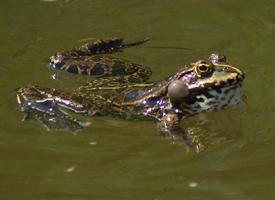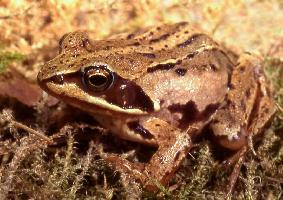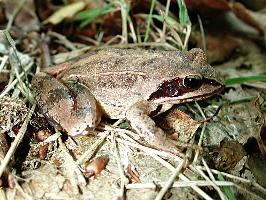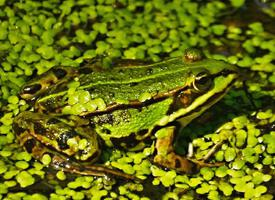
Váhy a míry
| Délka | od 12 do 16 cm |
|---|
Biologická data
| Délka života | od 5 do 10 let |
|---|
Popis zvířete
The Marsh Frog (Pelophylax ridibundus), also known as the European Green Frog, is a species of amphibian that belongs to the family Ranidae, the true frogs. This species is particularly notable for its widespread distribution across Europe and parts of Asia, making it a common sight in a variety of freshwater habitats. The Marsh Frog is the largest frog native to Europe, showcasing a remarkable adaptability and resilience that have allowed it to thrive in diverse environmental conditions.Physical Description:
Marsh Frogs exhibit a robust and agile physique, with adult individuals typically reaching lengths of up to 17 centimeters, although sizes can vary. They possess a smooth, moist skin that is predominantly green, although shades can range from olive green to almost brown, often adorned with dark spots or stripes that provide camouflage among vegetation. Their belly is usually lighter, ranging from white to yellowish, with males distinguished by a pair of vocal sacs on either side of their mouth, which they use during their loud and distinctive mating calls.
Behavior and Ecology:
Marsh Frogs are predominantly aquatic and are excellent swimmers, thanks to their powerful hind legs and webbed feet, which also make them proficient jumpers on land. They are most active during the night when they hunt for their prey, adopting a diet that mainly consists of insects, spiders, and other small invertebrates, although larger individuals may occasionally consume small vertebrates.
The breeding season for Marsh Frogs typically begins in the spring, when males gather in bodies of water and produce a chorus of calls to attract females. Females lay thousands of eggs in gelatinous clumps attached to underwater vegetation, which hatch into tadpoles before undergoing metamorphosis into juvenile frogs.
Habitat:
Marsh Frogs are highly adaptable and can be found in a wide range of freshwater environments, from large lakes and rivers to small ponds and marshes. They have a preference for habitats with abundant aquatic vegetation, which provides both food and shelter from predators. Despite their preference for water, Marsh Frogs can also venture into terrestrial environments, especially during wet weather.
Conservation Status:
Currently, the Marsh Frog is classified as Least Concern by the International Union for Conservation of Nature (IUCN), thanks to its wide distribution and large population sizes. However, like many amphibians, they face threats from habitat destruction, pollution, and climate change, which could impact their populations in the future. Conservation efforts are essential to monitor their populations and preserve their natural habitats to ensure the continued survival of this adaptable and fascinating species.
In summary, the Marsh Frog (Pelophylax ridibundus) is a remarkable amphibian, showcasing a blend of adaptability, resilience, and ecological significance across its extensive range. Its presence is a testament to the health and diversity of freshwater ecosystems in Europe and parts of Asia, making it a species of interest not only to herpetologists but also to those concerned with environmental conservation and biodiversity.
Podobná zvířata
Nové fotografie zvířat
Top 10 zvířat
- Chinese water dragon (Physignathus cocincinus)
- Galápagos tortoise (Geochelone nigra complex)
- Dolphin gull (Leucophaeus scoresbii)
- Japanese macaque (Macaca fuscata)
- Colombian red howler (Alouatta seniculus)
- Sea urchins (Echinoidea)
- Moustached guenon (Cercopithecus cephus)
- Diana monkey (Cercopithecus diana)
- Common reed warbler (Acrocephalus scirpaceus)
- Common house mosquito (Culex pipiens)


